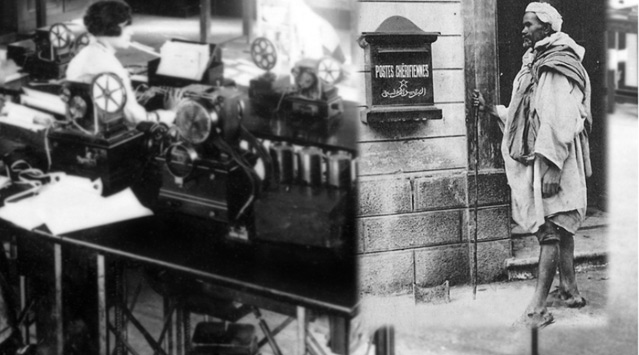TELEGRAPHE & PRECURSORS

Beacon Fires
Beacons fires were lit to alert the population to the approach of any enemies.
At the first sign of danger, an early warning beacon would be lit, which would be the signal for a whole chain of beacon fires, over a huge distance, to be successively lit; each one clearly visible from the next.
Beacons have been in use since ancient times. Did you know that the earliest reference to them was made by Homer in the
Iliad?
Two thousand seven hundred years ago he wrote:
“It came to pass that in a far distant isle under siege, whose men had spent the entire day in desperate battle on the city’s walls, smoke rose up from the city and ascended into the heavens. Then at set of sun, a long chain of beacon-fires burst into existence to warn the neighbouring villages of the danger and to appeal to them to embark on their ships to bring help.”
Ancient messengers
In Ancient Morocco, messages from the Sultan and other individuals were delivered by courier. These went about on foot to all of the towns, villages and bazaars. Others travelled out to local tribes, families and hamlets.
These couriers were known locally as Rekkas, Jari and Berrah.
Berrahs also acted as town criers, passing on verbal messages from the Sultan or other individuals. It was they who would announce, for example, any declaration of a state of war, or royal visits, births, marriages or deaths.
The optical telegraph
This instrument was invented in the chaotic years following the French Revolution, by Frenchman Claude Chappe (born-1763; died-1805). The very first telegram was sent from Paris to Lille in 1793 using the Chappe system.
Transmission was carried out by mechanical relays located in high places. Claude Chappe invented towers equipped with movable arms that could be arranged in 97 different positions. Each position had its own meaning, usually standing for a letter or number. Two optical telegraph stations could be placed up to ten kilometres from each other. In order for the system to work, it was necessary for there to be clear weather because the signals had to be observed through a good telescope and then relayed to the next station.
At that time, various aerial telegraph systems were developed in many countries for military use; all modelled on the French system.
Samuel Morse electrical telegraph
In the 1830s, Samuel Morse, an American, invented a telegraphic receiver which used a new system of communication via electromagnetic signals.
The device before you worked by combining different combinations of short signals (dots) and long signals (dashes), which represented the letters of the alphabet. For example, the letter “E” (the most frequently used in English) is represented by a dot, and the letter “T” by a dash. Can you guess how they represented the letter “A”? ...By a dot followed by a dash.
The signals were emitted using a device known as a straight key, which consisted of a spring lever operated by hand. They were then transcribed by the receiver by indenting them onto a paper strip. A rudimentary loudspeaker known as a “Sounder” allowed the signal to also be heard. The speed of transmission was some 25 words per minute.
After the appearance of the electrical telegraph, it became possible to transmit messages instantaneously, either along a cable between two telegraph posts, or between two distant telegraph stations thanks to wireless telegraphy (also known as WT).
David Edward Hughes teleprinter
This first telegraph device using printed characters was invented in 1855 by the American engineer David Edward Hughes, who lived from 1831 to 1900.
This device substituted the dots and dashes of Morse's telegraph for letters and numbers typed directly onto a keyboard.
In 1878, Hughes also invented a carbon-based microphone which converted acoustic signals into electrical signals. This instrument was used throughout the twentieth century in the majority of telephones because its frequency response was ideal for discerning the human voice.
Emile Baudot teleprinter
A few years after David Edward Hughes’ invention, the French engineer, Emile Baudot devised his teleprinter which you are now looking at. It worked using the first digital code, developed in 1874. The 5-bit code used was alphabetic. Characters were introduced using a keyboard with 5 keys, each of which corresponded to one of the 5-bits of each character. Six messages could be transmitted at the same time.
The arrival in Morocco of wireless telegraphy
In 1907, by order of Sultan Moulay Abdelaziz, the Makhzen authorities acquired all the equipment and stations needed for WT. It was installed by the French engineer Henri Popp, considered to be the first person to introduce wireless telegraphy into Morocco. He also founded the Moroccan Telegraph Company (usually known by its initials SMT).
At this time, the Makhzen authorities decided they would establish a monopoly. They created the first Moroccan Telegraphs Administration which was opened to the Public in February 1908.
The Belinograph or telephotography
The Belinograph was invented by Frenchman Édouard Belin in 1907, it is considered the precursor of the fax. Using this instrument, texts and documents and above all photographs (known as wire photos) could be transmitted by telegraphy.
The system worked by analysing a document, line by line, transforming its different levels of grey into frequencies. The receiving system then converted the inward bound frequencies corresponding to levels of gray into light intensities using a small light bulb. On receipt of the document, to get a copy of the original, all you had to do was develop the photographic paper in the receiving device.
The system was used extensively in 1955 by both domestic and foreign news agencies to transmit images of the return from exile of the late Mohammed V from Madagascar.

